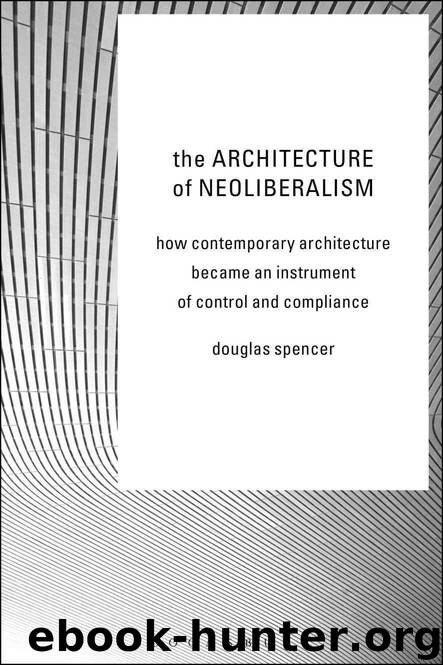The Architecture of Neoliberalism: How Contemporary Architecture Became an Instrument of Control and Compliance by Spencer Douglas

Author:Spencer, Douglas [Spencer, Douglas]
Language: eng
Format: azw3
Publisher: Bloomsbury Publishing
Published: 2016-10-19T16:00:00+00:00
Figure 12 OMA/Rem Koolhaas, construction detail, CCTV Headquarters, Beijing, 2002–12, photo: Ana Abram, 2008.
The ‘special character’ of neoliberalism in China lies in its structurally unique combination of market and state – a market-oriented political economy under the strict management of a centralized state authority. That the state should have a role within neoliberalism – principally that of legislating for and legitimating the conditions of the ‘free market’ – is, of course, by no means unique to China. It is the state form – that of the single party – and the powers of governance it has inherited from the era of Mao, that defines its ‘special character’. The apparatus of the party has been retained but redirected towards managerial rather than political objectives. As Hui observes of the party’s depoliticization: ‘In contemporary China the space for political debate has largely been eliminated. The party is no longer an organization with specific political values but a mechanism of power.’111 This ‘depoliticization process’, he continues, ‘has had two key characteristics: firstly, the “de-theorization” of the ideological sphere; secondly, making economic reform the sole focus of party work.’112
China’s movement towards a market economy, whatever the supposed gradualism of its transition, has involved the country in massive upheaval. While there is huge investment in urbanization and infrastructural development, arable land has become scarce. This has led to environmental crises and concerns over food security. The danwei (labour units), which once functioned as the essential instrument of social and political cohesion, have been progressively dismantled, cutting the citizen loose from their point of access to party ideology, as well as adrift from the basic mechanisms of social welfare. These radically changed conditions have not been received passively. Protests and ‘mass incidents’ of social unrest (scrupulously monitored and recorded by the CCP), around environmental and social problems, are frequent and numerous. Stabilizing these volatile conditions has become central to the work of the party, a task for which the mechanisms of neoliberal governmentality have been recognized as key.113 Lisa Rofel identifies neoliberal governmentality as a ‘project … to remake national public culture’.114 Aihwa Ong, theorizing neoliberalism as ‘a new relationship between government and knowledge through which governing activities are recast as nonpolitical and nonideological problems that need technical solutions’,115 notes the emergence of the concept of ‘reengineering the Chinese soul’ within organizational discourse in China: ‘Reengineering has become a metaphor for converting Chinese employees from particularistic cultural beings into self-disciplining professionals who can remanage themselves according to corporate rules and practice.’116
In the post-political, post-ideological conditions of post-reform China, image management has also become a central concern of the CCP. As Yuezhi Zhao writes, ‘As part of Deng’s “no debate” decree and perhaps the party leadership’s own increasing cynicism over its “truth,” the party has more or less given up its mission of political indoctrination to simply concentrate on the management of its own publicity.’117 These, then, are the practices of governmentality in which OMA’s CCTV headquarters are implicated – reengineering labour, remaking the public, stabilizing the social and managing the image.
Download
This site does not store any files on its server. We only index and link to content provided by other sites. Please contact the content providers to delete copyright contents if any and email us, we'll remove relevant links or contents immediately.
Kathy Andrews Collection by Kathy Andrews(11345)
The remains of the day by Kazuo Ishiguro(8419)
Paper Towns by Green John(4815)
Spare by Prince Harry The Duke of Sussex(4807)
Industrial Automation from Scratch: A hands-on guide to using sensors, actuators, PLCs, HMIs, and SCADA to automate industrial processes by Olushola Akande(4635)
The Body: A Guide for Occupants by Bill Bryson(4602)
Machine Learning at Scale with H2O by Gregory Keys | David Whiting(3670)
Be in a Treehouse by Pete Nelson(3654)
Harry Potter and the Goblet Of Fire by J.K. Rowling(3620)
Never by Ken Follett(3551)
Goodbye Paradise(3464)
The Remains of the Day by Kazuo Ishiguro(3148)
Into Thin Air by Jon Krakauer(3136)
The Cellar by Natasha Preston(3081)
The Genius of Japanese Carpentry by Azby Brown(3045)
Fairy Tale by Stephen King(2976)
120 Days of Sodom by Marquis de Sade(2947)
Drawing Shortcuts: Developing Quick Drawing Skills Using Today's Technology by Leggitt Jim(2943)
The Man Who Died Twice by Richard Osman(2824)
